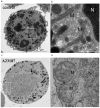NETosis: Molecular Mechanisms, Role in Physiology and Pathology
- PMID: 33202203
- PMCID: PMC7590568
- DOI: 10.1134/S0006297920100065
NETosis: Molecular Mechanisms, Role in Physiology and Pathology
Abstract
NETosis is a program for formation of neutrophil extracellular traps (NETs), which consist of modified chromatin decorated with bactericidal proteins from granules and cytoplasm. Various pathogens, antibodies and immune complexes, cytokines, microcrystals, and other physiological stimuli can cause NETosis. Induction of NETosis depends on reactive oxygen species (ROS), the main source of which is NADPH oxidase. Activation of NADPH oxidase depends on increase in the concentration of Ca2+ in the cytoplasm and in some cases on the generation of ROS in mitochondria. NETosis includes release of the granule components into the cytosol, modification of histones leading to chromatin decondensation, destruction of the nuclear envelope, as well as formation of pores in the plasma membrane. In this review, basic mechanisms of NETosis, as well as its role in the pathogenesis of some diseases including COVID-19 are discussed.
Conflict of interest statement
The authors declare no conflict of interest in financial or any other sphere. This article does not contain any studies with human participants or animals performed by any of the authors.
Figures


Similar articles
-
Entamoeba histolytica Trophozoites Induce a Rapid Non-classical NETosis Mechanism Independent of NOX2-Derived Reactive Oxygen Species and PAD4 Activity.Front Cell Infect Microbiol. 2018 Jun 5;8:184. doi: 10.3389/fcimb.2018.00184. eCollection 2018. Front Cell Infect Microbiol. 2018. PMID: 29922599 Free PMC article.
-
Histone Acetylation Promotes Neutrophil Extracellular Trap Formation.Biomolecules. 2019 Jan 18;9(1):32. doi: 10.3390/biom9010032. Biomolecules. 2019. PMID: 30669408 Free PMC article.
-
Mitochondrial permeability transition pore is involved in oxidative burst and NETosis of human neutrophils.Biochim Biophys Acta Mol Basis Dis. 2020 May 1;1866(5):165664. doi: 10.1016/j.bbadis.2020.165664. Epub 2020 Jan 8. Biochim Biophys Acta Mol Basis Dis. 2020. PMID: 31926265
-
How Do ROS Induce NETosis? Oxidative DNA Damage, DNA Repair, and Chromatin Decondensation.Biomolecules. 2024 Oct 16;14(10):1307. doi: 10.3390/biom14101307. Biomolecules. 2024. PMID: 39456240 Free PMC article. Review.
-
Multi-facets of neutrophil extracellular trap in infectious diseases: Moving beyond immunity.Microb Pathog. 2021 Sep;158:105066. doi: 10.1016/j.micpath.2021.105066. Epub 2021 Jun 24. Microb Pathog. 2021. PMID: 34174356 Review.
Cited by
-
A targetable pathway in neutrophils mitigates both arterial and venous thrombosis.Sci Transl Med. 2022 Aug 31;14(660):eabj7465. doi: 10.1126/scitranslmed.abj7465. Epub 2022 Aug 31. Sci Transl Med. 2022. PMID: 36044595 Free PMC article.
-
Mitochondria: a breakthrough in combating rheumatoid arthritis.Front Med (Lausanne). 2024 Aug 5;11:1439182. doi: 10.3389/fmed.2024.1439182. eCollection 2024. Front Med (Lausanne). 2024. PMID: 39161412 Free PMC article.
-
Tailoring therapies to counter the divergent immune landscapes of breast cancer.Front Cell Dev Biol. 2023 Feb 22;11:1111796. doi: 10.3389/fcell.2023.1111796. eCollection 2023. Front Cell Dev Biol. 2023. PMID: 36910138 Free PMC article. Review.
-
Plasma Gelsolin Enhances Phagocytosis of Candida auris by Human Neutrophils through Scavenger Receptor Class B.Microbiol Spectr. 2023 Feb 21;11(2):e0408222. doi: 10.1128/spectrum.04082-22. Online ahead of print. Microbiol Spectr. 2023. PMID: 36802172 Free PMC article.
-
Dalbavancin Boosts the Ability of Neutrophils to Fight Methicillin-Resistant Staphylococcus aureus.Int J Mol Sci. 2023 Jan 28;24(3):2541. doi: 10.3390/ijms24032541. Int J Mol Sci. 2023. PMID: 36768864 Free PMC article.
References
Publication types
MeSH terms
Substances
LinkOut - more resources
Full Text Sources
Medical
Miscellaneous

